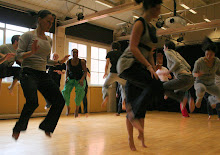Question 1
Through out the first five weeks of creating Porto; there have been a few strategies used in the devising process. The one, however, that has been most effective is improvisation, as this allows ‘develop[ment] [of] individuals characters’ (Heddon & Milling, 2006: p.g. 57) and the work of the ensemble. The use of improvisation, or ‘play’, can ‘contain possibilities for performance’ (Tufnell & Crickmay, 1990: p.g. 193). Improvisation is also a ‘source of creativity and as a way of opening imagination’ (Tufnell & Crickmay, 1990: Introduction), thus allowing the creation of original material. Before, improvisation begins, the ensemble, were given an idea that the improvisation consist around. It is the ensembles or individuals characters that lead the improvisation and ‘generates material which […] could never be planned […] by logical means’ (Tufnell & Crickmay, 1990: p.g. 194). The use of improvisation with both smaller and larger groups can create ‘dialogue [through] motion. They relate to each other […] communicating by sensing each others presence through […] weight and energy’ (Anderson, 1997: p.g. 247/8). Overall, the use of improvisation, allows the creativity of new material, the refinement of that work, while also allowing growth for individual characters as the piece develops and the work becomes more intense.
Question 2
When the devising process of Porto began, my character, which I was initially working with, was an exaggerated version of myself. However, as the weeks progressed, I found it difficult for my character to progress as my ‘character’ was far too personal. My ‘character’ could only grow if I, myself, grew through the work. It wasn’t until the last weeks rehearsal, that I found a character; a character that I can now continue to use and work with through out the rehearsal and performance period. ‘Creating a character all too often gives the impression that the character is an object logically constructed by the mind and then put into the body’ (Zarrilli, 2002: p.g.12). I don’t agree with the statement, when it comes to this genre of work, as I found my new character from the emotional and physical dialogue that occurred between myself and another performer. It was this ‘non-logical’ but emotionally driven connection that has got me the character I have found and will use now. It will be through out the following rehearsal periods that I will get to explore my character by spending more time with the character that I have found and emotional with, while ‘explor[ing] the creation of a character by physicalizing a ‘psychological gesture [for it]’ (Zarrilli, 2002: p.g.13).
Question 3
As, just stated, it is only in the following weeks that I can explore, change and refine elements of my character because I have only just discovered my character, however, from an understanding of my character, I can begin to consider my characters physicality and body language. ‘Our bodies are the reflections of our lives […] each thought and sensation makes changes in the body’ (Tufnell & Crickmay, 1990: p.g.1). Using this idea, it allows the creation of characters to become a more realistic image of said character and the elements it must face. My characters relationship towards the element of gravity is both in and not in favour of it. His feet are in favour, as his feet are firmly grounded to the floor, but, however, tries to ‘defy’ gravity as his spine is completely straight; creating a strong, proud stance, trying to appear stronger and confident than the rest of the ensemble. My character uses every part of its skeleton to its ability, ‘the head directs, the torso is the power house, the arms act upon the world and the legs move the body around’ (Tufnell & Crickmay, 1990: p.g.36), these elements are defiantly how my character uses its body to work the performance space in Porto. One key gesture, my character has already achieved, is a look of disgust on his face towards the other characters in Porto, creating an image of disgust and importance which allows ‘the soul of the character and the physical body of the performer [to] meet’ (Zarrilli, 2002: p.g.12).
Bibliography
Anderson, J. (1997) Art Without Boundaries. London. Dance Books Ltd.
Heddon, D. & Milling, J. (2006) Devising Performance: a critical history. Hampshire. Palgrave Macmillan
Tufnell, M. & Crickmay, C. (1900) Body, Space, Image. London. Virago Press
Zarrilli, P. (2002) Acting (Re)Considered: A theoretical and practical guide, 2nd ed. Oxon. Routledge
Posted by: EDWARD CRITCHLOW
skip to main |
skip to sidebar
Welcome to Porto2009.
This is the begining of our journey on the road of Porto2009. And the blog will give us the opportunity as a group to reflect on the work in which we have done within the sessions. We will keep you posted regarding the process we are making along the way.....
Enjoy.
Enjoy.



No comments:
Post a Comment